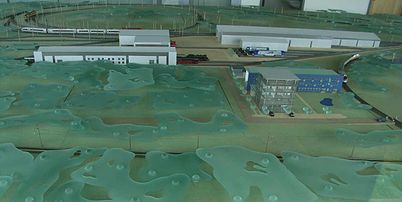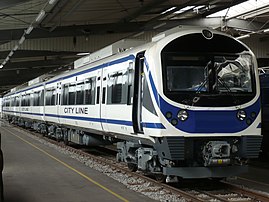Wegberg-Wildenrath test center
The Wegberg-Wildenrath Test Center (official name: Test and Validation Center Wegberg-Wildenrath , PCW for short ) of Siemens Mobility GmbH is a facility for initial commissioning, type testing, acceptance and repair of rail vehicles and rail systems.
The test center is located in Wegberg - Wildenrath in Kreis Heinsberg in North Rhine-Westphalia and belongs since October 1, 2014 the Division Siemens Mobility , formerly Siemens Infrastructure & Cities Sector Division Rail Systems . It is recognized by the Federal Railway Authority as a testing center for typical railway tests and as an expert body for vehicle systems that require monitoring in accordance with Section 33 EBO . Siemens also offers the facility to third-party companies.
The test center employs around 430 people. It is one of eight such test centers worldwide and is considered to be the most modern.
Structure and facilities
The 28 kilometer long track network of the facility consists of two test rings and three test tracks, which, in addition to standard gauge , are also designed in meter gauge on the small test ring . This inner ring can therefore be used by trams if necessary . On the outer 6.1 kilometer long test ring with arc radii of around 700 meters, speeds of up to 160 km / h can be driven, and on the inner 2.5 kilometer long ring with radii of 300 meters up to 100 km / h. 80 km / h can be achieved in dry weather on a 1.5 km long straight test track. A 410 meter long track has ramps with gradients of four and seven percent (over 2.5 percent is a steep stretch ). Another 553 meter long track with curved radii of 50, 25 and 15 meters was dismantled in favor of an extension of train formation hall 2. A 50 meter long measuring track curve with a curve radius of 150 meters is used to determine the wheel contact and wheel guidance forces and thus to test the safety against derailment. There is also a siding from West-Gleis GmbH, which connects the test center to the rail network of Deutsche Bahn via the Wegberg Klinkum – Wegberg-Wildenrath test center and then via the Dalheim-Rheydt railway .
Train formation hall 1 has a total of nine tracks of up to 220 meters in length with overhead lines, some with a pit and some elevated. A 75 meter long track is also laid out in meter gauge. There are also three stands for roofing work.
Train formation hall 2 has three standard-gauge , elevated tracks with overhead lines and a pit, each 220 meters long. This was extended in order to completely accommodate the 400-meter-long Velaro Eurostar . There is also a bogie sink in which special measuring bogies can be installed, as well as an extraction system for exhaust gases from diesel vehicles.
On a turn-tilt table for standard and meter gauge vehicles, curve, depression and hilltop journeys can be simulated. A tilting device measures the rolling behavior by inclining the vehicle in order to simulate the influence of lateral accelerations such as cross winds and centrifugal forces. With the help of an acoustic measuring device, internal and external noise tests can be carried out up to a speed of 160 km / h.
For the electrical energy supply of the locomotives, there are both overhead lines and busbars (large ring: English design, small ring Berlin design), which can be operated with a wide variety of current types. The large test ring is equipped with the train control systems PZB , ETCS Level 1 and 2 and the Dutch ATB . Additional train control systems can be installed temporarily. Leak tests can be carried out with a sprinkler system.
Siemens also makes the test systems available to other rail vehicle manufacturers. By the beginning of 2010, 110 million euros had been invested in the project.
The RWTH Aachen tests the in Wildenrath Galileo satellite navigation system . For this purpose, pseudolites were installed on eight 50-meter-high transmission masts that simulate real satellites. The aim is a satellite-based shunting operation. The CargoMover is used as a test vehicle .
- Wegberg-Wildenrath test center
Series 407 (ICE Velaro D) in the test center, 2012
Desiro of the Thai State Railways in a train formation hall
history
The testing facility is located on 35 hectares of the former NATO airfield RAF Wildenrath of the Royal Air Force Germany . It was opened in mid-1997 and initially employed 80 people. By 2012, the number of employees here rose to around 900 (including external companies).
The decision to convert was made at the beginning of 1995. Initially, up to 90 million DM should be invested. For the core area of the test center, 20 hectares of land were purchased, around 15 hectares were leased for the test tracks and options for expansion were agreed. The two planned track rings, with radii of around 400 and 1275 meters, should have a circumference of 2.5 and 6 kilometers. Completion was scheduled for 1997.
In spring 1998 it was planned to build a climatic wind chamber by January 2000. The facility was intended to replace the outdated facility in Vienna's Arsenal and to be built on a 4.4 hectare property and to be reached via an existing siding. The planned maximum wind speed was 160 km / h. The approval process for the climatic wind chamber was completed at the end of 1998. Commissioning of the DM 84 million facility was scheduled for the end of 2000. In addition, at the beginning of 1999 the integration of further test and inspection facilities was examined, including an extension of the Dalheim – Rheydt section to a speed of 240 km / h. There were also plans to build a visitor center. None of the projects was implemented.
A further expansion of the facility was decided in the spring of 1999 to the amount of 23 million DM. Another test hall with track systems was to be built, as well as a parking facility for new vehicles in the Rheydt shunting yard . The total investment volume rose to a total of 133 million DM. The parking facility at the Rheydt marshalling yard is still in use today.
A year later there were capacity problems when numerous vehicles from the 152 , 403 , 406 , 424 , 605 and 642 series were parked there at the same time. As a result, individual trains of the 605 series were temporarily parked at an additional rented area in Ratheim station . Due to a lack of capacity, type testing of the Desiro UK was largely relocated to the Velim Railway Test Ring in mid-2002 .
In the autumn of the same year, Adtranz , Alstom LHB and Bombardier signed an agreement in principle with Siemens and the Ministry of Economics, Medium-Sized Enterprises, Energy and Transport of the State of North Rhine-Westphalia on the non-competitive opening of the test center in order to ensure the competitiveness of the German rail industry. According to these plans, a neutral operating company should market around 15 percent of the plant's normal capacity (worth around 1.5 million euros) for research, development and commissioning. The ten-year agreement included an option to increase it to 50 percent. Rail Test GmbH later took over the operation of the facility . In addition to Siemens' own use, TÜV Inter-Traffic GmbH , the Institute for Railway Technology , the Study Society for Underground Transport Systems and TÜV Süd were also involved in the company.
By mid-2001, Siemens said it had invested more than DM 150 million in expanding the plant. The company announced that it would invest another DM 36 million in the plant by the end of 2002. Among other things, the aim was to electrify the railway line between Rheydt and Wildenrath and to build a test track for a maximum speed of 240 km / h near the test center. In addition, a system for testing radio operation was planned. The existing infrastructure was to be optimized for the testing of local trains and the power supply for different voltages expanded. The second train formation hall went into operation around 2002.
In 2012, construction began on a multi-functional hall costing twelve million euros. According to its own information, Siemens has invested a total of 127.5 million euros in the Wildenrath location since 1997. In 2015, the British Class 700 was tested on the large test ring.
See also
Web links
Coordinates: 51 ° 6 ′ 57 ″ N , 6 ° 13 ′ 5 ″ E
- Location on the OpenRailwayMap
Individual evidence
- ↑ Tests and validation. In: siemens.com. Retrieved November 21, 2018 .
- ↑ Dietmar Seher: To the limit of possibilities . In: private railways . tape 11 , no. 3 , March 2017, ISSN 1865-0163 , p. 46-49 .
- ↑ Wegberg: Siemens continues to invest in the oval ( memento of the original from January 19, 2010 in the Internet Archive ) Info: The archive link was inserted automatically and has not yet been checked. Please check the original and archive link according to the instructions and then remove this notice. . In: Rheinische Post (online edition), January 13, 2010
- ↑ Article of May 23, 2015 from RP-Online , accessed on June 12, 2015
- ↑ Test environment ( memento from December 21, 2013 in the Internet Archive ) on railgate.de , accessed on December 20, 2013.
- ^ Initial project Rail ( Memento from December 21, 2013 in the Internet Archive ) on railgate.de , accessed on December 20, 2013.
- ↑ a b Report on expansion of the Wildenrath test center . In: Eisenbahn-Revue International , issue 5, year 1999, ISSN 1421-2811 , p. 173.
- ↑ a b Michael Heckers: A feast day for “puffer kissers” . In: Rheinische Post (online edition), June 26, 2012.
- ↑ There is construction going on in Wildenrath . In: Railway technical review . tape 44 , no. 3 , 1995, p. 129 .
- ↑ Announcement climatic wind chamber . In: Eisenbahn-Revue International , Issue 6, 1998, ISSN 1421-2811 , p. 228
- ↑ Notification of approval for climatic wind chamber . In: Eisenbahn-Revue International , Issue 1/2, 1999, ISSN 1421-2811 , p. 12
- ↑ a b Report to the National Rail Testing Center . In: Eisenbahn-Revue International , issue 11/2000, ISSN 1421-2811 , p. 490.
- ↑ Report on space problems in Wildenrath . In: Eisenbahn-Revue International , issue 6/2000, ISSN 1421-2811 , p. 246.
- ^ Message from Desiro UK in Velim . In: Eisenbahn-Revue International , issue 10/2002, ISSN 1421-2811 , p. 468.
- ^ Report to TÜV in Wildenrath . In: Eisenbahn-Revue International , issue 10/2002, ISSN 1421-2811 , p. 443.
- ^ Peter Schmied: 33rd conference "Modern Rail Vehicles" in Graz . In: Eisenbahn-Revue International , issue 7/2001, ISSN 1421-2811 , pp. 312-314.
- ↑ Report on expansion of the Wildenrath test center . In: Eisenbahn-Revue International , issue 10/2001, ISSN 1421-2811 , p. 436.
- ^ Message ICE 3 conversion . In: Eisenbahn-Revue International , issue 10/2002, ISSN 1421-2811 , p. 443.
- ↑ Michael Heckers: Wegberg: Siemens is expanding test center . In: Rheinische Post (online edition), April 25, 2012.
- ↑ Chris Jackson: Class 700 is on track . In: Railway Gazette International . tape 171 , no. 5 , 2015, ISSN 0373-5346 , p. 44 f .





